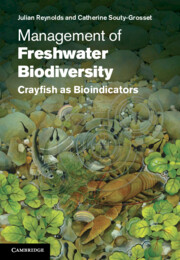Book contents
- Frontmatter
- Contents
- Preface
- Acknowledgements
- Introduction: Biodiversity in freshwater systems, and the key roles played by crayfish
- Part I The present situation of crayfish in world freshwater ecosystems
- Part II Applying science to conservation management
- Part III Knowledge transfer for successful crayfish management
- 10 Effective legislation and public education for adequate conservation of crayfish and biodiversity
- 11 Management strategies to protect crayfish and biodiversity
- 12 Maintaining biological diversity and human well-being
- References
- Glossary
- Index
- Scientific and common English names of well-studied crayfish featured in this book
- Common English and scientific names of well-studied crayfish featured in this book
- Plate section
10 - Effective legislation and public education for adequate conservation of crayfish and biodiversity
from Part III - Knowledge transfer for successful crayfish management
Published online by Cambridge University Press: 05 December 2011
- Frontmatter
- Contents
- Preface
- Acknowledgements
- Introduction: Biodiversity in freshwater systems, and the key roles played by crayfish
- Part I The present situation of crayfish in world freshwater ecosystems
- Part II Applying science to conservation management
- Part III Knowledge transfer for successful crayfish management
- 10 Effective legislation and public education for adequate conservation of crayfish and biodiversity
- 11 Management strategies to protect crayfish and biodiversity
- 12 Maintaining biological diversity and human well-being
- References
- Glossary
- Index
- Scientific and common English names of well-studied crayfish featured in this book
- Common English and scientific names of well-studied crayfish featured in this book
- Plate section
Summary
Legislative controls on crayfish: the international situation
As earlier chapters have shown, much of global biological diversity resides in fresh waters, but proportionately more freshwater species are endangered than in other biomes, largely because of increasing human demands on a restricted resource. Decapods (crabs and crayfish) are considered among the most threatened of freshwater invertebrates, with 168 decapod species on the IUCNRed List of Threatened and Vulnerable Species (2003). On average, 40% of crayfish are considered threatened. Many crayfish species also appear on international and national Red Lists and are afforded some protection. However, not enough is being done to publicize this situation and to explain to the public why this is so important. Furthermore, working against national or international protection are some international conventions, such as the World Trade Organization treaties to which many countries are signatories. In some specific cases, this has forced the importation of alien species despite their known damaging impacts. Some case examples are given later in the chapter.
For the first time in international law, the 1992 Convention on Biological Diversity (CBD) recognized that the conservation of biodiversity is a common human concern and integral to the development process. The agreement covers all ecosystems, species and genetic resources, and links traditional conservation efforts to the economic goal of sustainable use of biological resources. While past conservation efforts were aimed at protecting particular species and habitats, the Convention recognizes that ecosystems, species and genes must be used sustainably for the benefit of humans in such a way that it does not lead to the long-term decline of biological diversity.
- Type
- Chapter
- Information
- Management of Freshwater BiodiversityCrayfish as Bioindicators, pp. 239 - 270Publisher: Cambridge University PressPrint publication year: 2011

